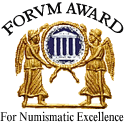|
|
|
|
Counterfeit 1799 U.S. silver dollar |
|
|
|
|
|
|
The electronic age has created marvelous new opportunities for coin enthusiasts to add to their collections and to their store of knowledge. But it has also opened up new opportunities for coin scammers. Cheating has always been a part of the world of money, including the world of collecting money. The Internet just makes it easier to cheat, and be cheated. Not all of the coin collecting consumer information below is specific to the online world or to deception in numismatics. But it's all relevant to the coin consumer in the information age. Consider this a coin consumer protection guide.
Counterfeit Coin Detection Primer Coin Grading and Authentication Services Coin Toning: Real, Artificial, In Between? Getting the Most from Coin Price Guides Censorship in Numismatic Discussion Groups Getting Started With Ancient Coins Attributing Ancient Greek Coins (SNGs) Language, Empire, and Ancient Coin Scholarship Looting, Smuggling, and Ancient Coins
Some of the coin consumer protection material here appeared earlier in a different format in articles of mine in Coin World, Coins magazine, Coin Values magazine, and The Celator magazine. |
|
|||


